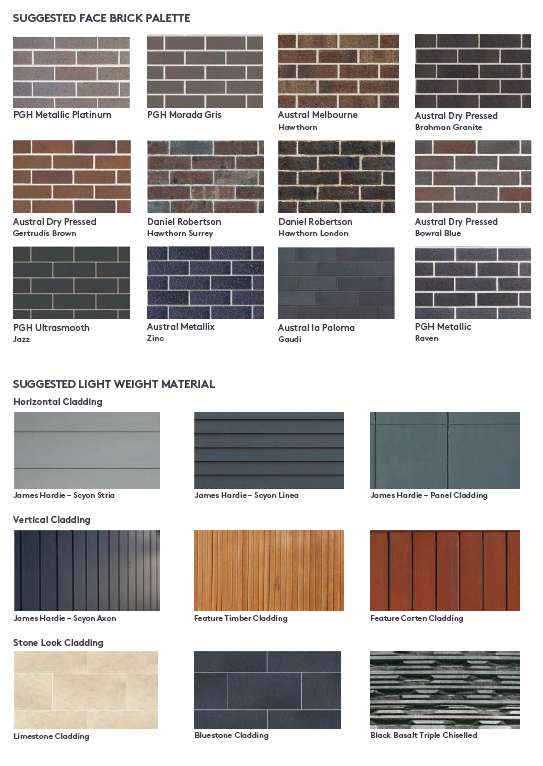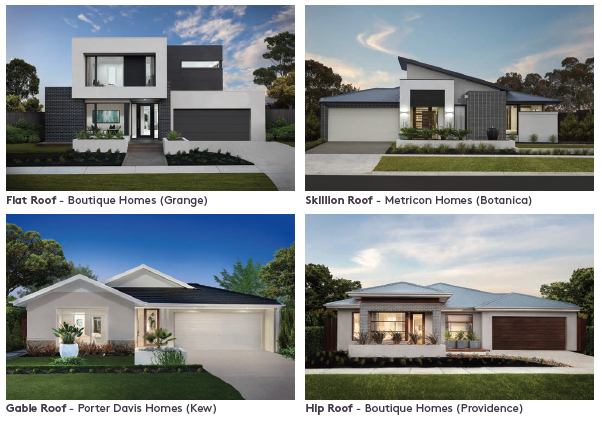Home Style Guide
- Face brickwork is to architecturally complement the dwelling design. Face brickwork is not to be mottled or blend brickwork with significant colour contrast.
- External walls that are not visible from the street or open space must be constructed in colours and materials consistent with the front facade of the home.
- Selective use of other wall materials will be considered on the merits of the proposed finishes.
- Aluminium, stone and steel elements should only be used in the facade as points of visual interest.
- All ancillary items such as balconies, posts, verandahs, porticos, pergolas, balustrades, down pipes and gutters and other minor architectural detailing items must be of a similar colour to one of the selected façade colours.
- Lightweight infills are not permitted above any window openings along facades directly visible from the street or public open space. Infills are permitted above garage doors where the colour matches the garage door colour.
- The main colours of the façade should be light, natural and earthy colours with deeper, highlight colours to articulate design elements and create contrast. Refer to page 11 & 12 for colour and material suggestions. Please note that these are not pre-approved and are subject to the approval of the DRP.
- Highly reflective window tints are not permitted.
- External security blinds and roller shutters are not permitted.
- Front security doors must complement the style of the home and not dominate the façade.
Contemporary Australian architecture will best define the style of housing to be delivered at Olivine. This will be achieved through simple forms and well proportioned façade elements combined with controlled use of materials and colours as described in the following sections. Typical examples of the types of housing outcomes preferred at the site and envisaged by these Design Guidelines are provided below. Faux heritage styles and features are not permitted.
Ceiling and Building Heights
All dwelling designs within Olivine are required to ensure all ceiling and building heights comply with ‘ResCode’. Compliance with the above statutory requirements will be assessed by your Building Surveyor.
- Unless approved by the DRP, a minimum ceiling height of 2,550mm is required for all single storey dwellings and the ground floor of double storey dwellings.
- Triple storey dwellings and/or basements should adhere to the relevant height requirements. Basements may have a maximum projection of 1.2m above natural ground level.
Colour and Material Palettes
Colour and material palettes must respect the following design controls;
- Your home’s façade must incorporate a minimum total of two (2) and a maximum of four (4) materials or finishes. One material or finish may constitute up to 70% of the overall front façade and as a general guide facades are encouraged to use two colours with other limited highlight colour. A front façade featuring all one colour or material will not be approved.
- Acceptable wall materials include:
• Masonry and face brickwork (untreated).
• A rendered and painted texture finish over either masonry or lightweight cladding.
• A bagged and painted finish over either masonry or lightweight cladding.
• Weatherboard stained or with a low reflective painted finish.
• Fibre cement wall cladding, feature panel finish and/or fibre cement wall cladding with timber batten cover strips.
• Clear finished timber sheets or boards.
• Untreated concrete blockwork or precast concrete is prohibited.


Roofs & Eaves
Where there is a difference in height between two adjoining properties the maximum 1.8m fencing height is measured from the higher of the two lots. If a retaining wall is required the maximum height of the retaining wall height must be 500mm unless otherwise approved. Retaining walls must be timer, and appear harmonious with fence materials.
- Roof forms should generally be pitched (i.e. gabled, hipped and skillion roof forms), with feature flat elements permitted where box guttering is hidden from view. Entirely alternative roof forms will be considered subject to design merit.
- Where pitched (gable/hipped) roofs are used, the roof pitch must be a minimum of 22 degrees.
- Where skillion roofs are used the roof pitch must be a minimum of 10 degrees.
- Roofs must be finished in one of the following materials:
- Concrete low profile tiles
- Non-reflective corrugated metal deck roofing
- Where flat roofs of less than 5 degrees are applied, a parapet must fully conceal the roof from the public realm. Construction may be of metal deck roofing or similar material.
Eaves and parapets must comply with the below design controls;
- Single storey homes with a pitched roof must include minimum 450mm eaves on the front facade and return 4m along the sides of the home.
- Eaves (minimum 450mm) are required to all sides of the home that face a street or public open space.
- Double storey homes with a pitched roof must include minimum 450mm eaves to all sides of the home on the upper storey.
- No eaves are required along the side of the garage if the garage is built 0-200mm oõ the side boundary.

